originally posted at https://canmom.tumblr.com/post/632603...
みなさん、今晩は!アニメの時間だよ!木曜日に、テーマは時代劇とチャンバラです。
Good evening, everyone! It’s time for anime! This Thursday, the theme is period dramas and samurai films.
…hopefully that doesn’t have any egregious errors of grammar or tone.
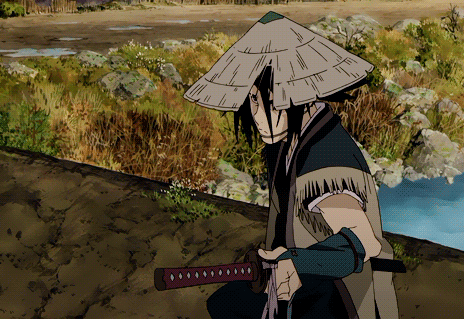
Before we get to introducing our main features tonight, let’s drop some historical context! By which I mean a lot of historical context. With anime gifs.
A medium-length history of the samurai
For much of Japan’s later history, the country (though by no means always unified as a ‘country’) was effectively ruled by the feudal landlord samurai (侍)or bushi (武士) caste.
Until really the last couple of hundred years, economic and social power in Japan was concerned with control over rice. However, the groups that ultimately became the samurai were not always aristocrats. Although early use of the term “samurai” for low-ranking bureaucrats may date back all the way to the 600s, the samurai as distinct caste are have their origins in Emperor Kanmu’s expansionist wars against the Emishi people in the late 700s/early 800s, during which peasant conscripts proved inadequate and horse archers - whose training and upkeep was very expensive - became dominant in warfare. In Japan to 1600: A Social and Economic History, William Wayne Farris writes:
These long wars helped lay the foundation for the classical samurai way of doing battle. From these small bands of emishi riders, the court learned that leather armor was better suited to mounted warfare and soon abandoned iron. The emishi also wielded a curved sword, instead of the straight one employed by government soldiers. The emishi curved sword was probably the predecessor of the vaunted samurai slashing weapon. Because most engagements involved mounted archers, there were many opportunities for the government’s equestrian elite to hone its skills. In other words, these long wars constituted “practice for becoming samurai.” With the cessation of hostilities in 812, the technology of the samurai had come together: they were lightly armored mounted archers wielding curved swords.
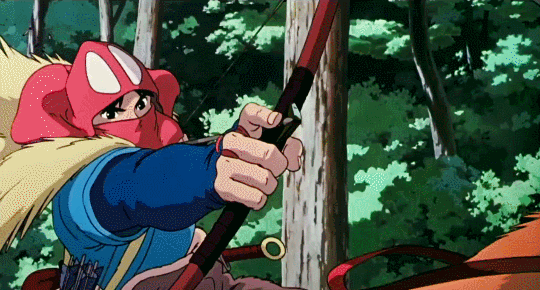
(this scene from Mononoke-Hime depicts a much later period when firearms were coming into use, and a ‘red elk’ instead of a horse, but I don’t have a lot of choices for illustrating horse archery :p )
After the end of these wars, Japan entered a long period of population decline, leading to knock-on failures in an imperial court unable to gather sufficent revenue which thinned out the existing aristocracy. This set the stage for a series of rebellions; the Imperial court, whose main military strength was naval, defeated them by setting other criminals against the rebels, and awarding them with ranks and governorships afterwards. Farris writes:
The court rewarded all these men with governorships and rank, thereby making them tax farmers and members of the lower aristocracy. As described above, the Heian class system was “frozen” into a familial status hierarchy; descendants of the men who had crushed these revolts gained recognition as the exclusive practitioners of the “way of the bow and horse.” These houses encompassed not merely several branches of the Taira and Minamoto, but also the Òkura, the Tachibana, and the Hidesato line of the Fujiwara (not to be confused with the Fujiwara at court). In the capital they were the “hired assassins” of the highborn, while in the provinces they controlled from their fortified compounds small forces of peasant foot soldiers. They especially coveted appointment as tax farmers. By the tenth century, military men had added a social dimension, as the practitioners of mounted archery belonged to certain exclusive lineages, often ranked among the lower aristocracy.
Around the beginning of the 1000s, a series of epidemics hit the agricultural population hard, leaving many fields lying fallow. To counteract this, the government created a policy formalising the previously-unofficial hereditary estates (shōen). Within the shōen, land was not individually owned (the landlord usually living in faraway Kyoto, but residents were entitled to a certain portion of the produce. During this time, the warriors were increasingly put in charge of managing the estates (since they could use violence to coerce labour), and can properly be called samurai. At this point, the samurai were by no means dominant; they formed one of the three major institutions of Heian-era Japanese elite society, alongside clergy and ‘civil aristocrats’.
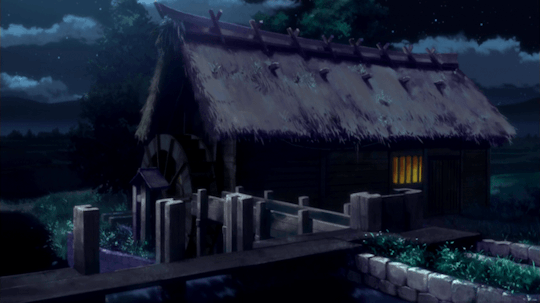
Over the next couple of centuries, as the population bounced back a little from its decline, the samurai - still mostly serving the state as tax collectors and estate managers - started to get into the habit of fighting each other in duels for status. Farris describes how these would go down:
by 1100 combat was almost always one-on-one. Battles took no planning and usually turned into groups of riders skirmishing with each other. Donning colorful armor sewn together with brightly tinted thread, these warriors were always careful to choose a foe worthy of their own status and prowess. Before engaging in combat, a rider would frequently announce his pedigree—his name and lineage, his home, and his battle experience—to his opponent. Then the two fought an archery battle from horseback, jousting for the advantage (maneuvering one’s opponent to the left, or bow, side). When one warrior had succeeded in wounding or unseating his enemy, his attendants would decapitate the rival and the head would become a trophy and the basis for reward. In this form of combat, the identity of the enemy was all important, a deadly dance aiming to establish hierarchy and dominance among males.
Shit hit the fan around 1180, with a civil war nominally over imperial succession which was, according to Farris, mostly about the income and status of the samurai. The war was ultimately won by the military leader Minamoto no Yoritomo, who created a new accord where the samurai, who had been withholding rents from the court in order to provision their armies, would control many estates and fully control the transfer of rent to the other parts of the aristocracy.
The new government after the rebellion had major two poles: the traditional aristocracy and the new Kamakura bakufu, or ‘tent government’, controlled by the military which held power over the Eastern parts of the country. After Yoritomo dealt with his military rivals, he was granted the title of sei-i-taishògun (great barbarian-quelling generalissimo), which when shortened to shogun became the general title of the leader of the military government.

(this gif is from a PC-98 game about the genpei war apparently?)
At this point in the story comes the two attempted mongol invasions in 1274 and 1281. Famously, a typhoon hit the vast mongol fleet before they could destroy the vastly outnumbered forces of the samurai; this entered legend as the kamikaze or ‘divine wind’, later appropriated by the imperialist government to refer to suicide dive-bombers.
To give a very brief window on the rest of the non-samurai population, throughout most of this period, Japan was widely afflicted by disease and famine. In the 1230s things got so severe that the government legalised families selling their children into slavery. The aftermath of this policy created a large ‘servile class’ alongside the peasants. As is common in times of scarcity and famine, many people turned to banditry, severely testing the Kamakura shogunate’s ability to maintain control. The samurai, who had pretty wide permission to take what they wanted from the peasants, were cruel landlords, to the point that it further threatened agriculture:
During war and peace, samurai serving as on-site landlords regularly abused their cultivators, resulting in peasant deaths or their flight from agriculture. For instance, at Ategawa Estate in 1275, the on-site samurai bound up the wives and children of farmers who refused to sow wheat. The men having fled to the mountains, the samurai proceeded to slice off the ears, cut off the noses, and shave the heads of the remaining family members. This case was eventually adjudicated, but the warrior won.
Landlords, huh?
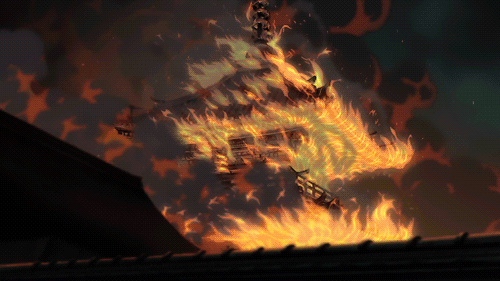
In such conditions, the Kamakura shogunate came to an end in the 1300s. The Emperor Go-Daigo saw a chance for the Imperial house to get some real power back, and organised the various dispossessed bandits and less-loyal samurai to rebel against the Kamakura. As a result, the city of Kamakura was incinerated and the members of the dominant Hōjō family allegedly killed themselves en masse.
But Go-Daigo’s revolution still ultimately failed, and most of the 1300s were spent in, you guessed it, yet more devastating wars. The outcome was that, at last, the samurai held real hegemony over the other parts of society, creating a new shogunate that ruled from the Muromachi section of Kyoto. This is when the military feudal lords, called daimyō, became established. These local warlords were afforded the right to collect taxes from provinces, and in charge of land disputes and such. They contributed about half the take for the shogun, in return for military support from his much bigger army.
Around this time, Japan managed to get a bit of a break from the grip of famines and people were increasingly immune to disease, so the population - and economic surplus - started to grow for real. Even when famine did strike, there were more effective mechanisms for relief in terms of merchant charity in the cities, that stopped the total collapse into banditry etc.
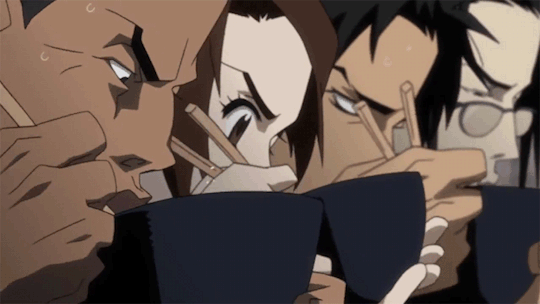
It wasn’t all good news. A big reason for things continuing to suck was our old friends, the samurai, who still robbed the populace to provision their wars. These new aristocrats are described by H. Paul Varley as “extravagant, rambunctious, and lawless”, which makes them sound way more fun than they probably actually were. There’s an anecdote in Farris’s book about one daimyō, Sasaki Dōyo, who in 1340 was part of an escalating squabble with a temple: Sasaki and his mates stole some maple branches from a temple, the temple’s servants attacked them, so Sasaki gathered a bunch of samurai and burned down the temple. For this, he was exiled, but he treated the whole thing more as a pleasure cruise.
At the same time, the status of women got really bad. In most of the previous eras, though polygyny was commonly the rule, women had been heavily involved in most going-on in a pretty equal way, able to own property and afforded plenty of respect and status. Under the Muromachi, however, patrilineal ie (stem families) became important among commoners, while increasingly the male aristocrats limited the movements of their wives, their right to divorce, and their ability to go without punishment for divorce. Official misogyny became more common in the temples. Though curiously, this situation did lead to the rise of blind women as travelling performers - a concept which shows up in Samurai Champloo, albeit in a much later era.
Farris laments in his book that historians don’t really know why the status of women fell so suddenly, offering a list of possible reasons and shooting down each one. But I think I’m getting off track…
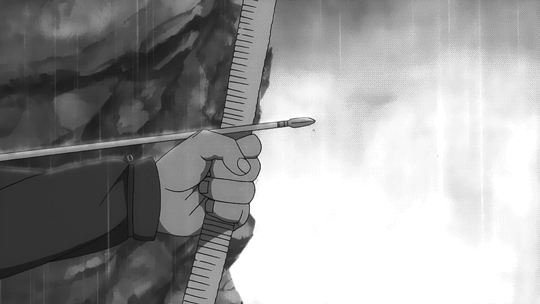
Guess what, everyone? It’s time for the Sengoku period. If we thought things were bloody and nasty before, just you wait.
Those Muromachi guys gradually lost control following the assassination of the ‘despotic’ shogun Ashikaga Yoshinori in 1441. The next couple of shoguns were, respectively, dead of dysentery after just three years, and then a baby. By the 1460s, things fell apart over all kinds of succession disputes until, eventually, it kicked into war. The war involved intense guerilla fighting in Kyoto, and by the time the combatants went home in the 1470s, the city was a ruin. When they tried to rebuild it, it burned down again. Twice!
The daimyōs, whose control over their provinces was insecure, were in trouble as their backing from the centre collapsed. Many such centrally appointed daimyō were kicked out by local forces, who won the support of peasants by promising less taxation. These became the new daimyō, and with the shogunate basically disappearing as a meaningful force, these new daimyō set about competing for territory and mobilising increasingly big armies in what became known as the ‘Warring States’ or Sengoku period [戦国時代 sengoku jidai] (1477-1590), in reference to a vaguely similar period in China.
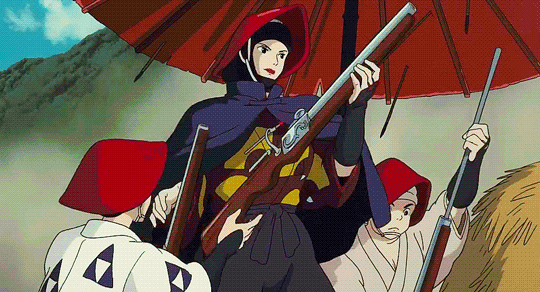
A whole lot of samurai stories take place in this period. Its appeal is like Westerns: a time when society breaks down and extreme violence is normal. Daimyōs would take control at home and set about on yearly wars to seize more land, limited mostly by the supply of food. Though most of the casualties of war were still in disease and starvation, battlefield casualties started to grow. This got all the worse in the 1540s, when the Portugese showed up and started handing out guns, and also syphilis. The daimyō were delighted to be able to start blowing the shit out of each other and set about learning to make guns themselves. And pretty much everyone got syphilis.
The samurai in the warring states period became deeply familiar with war economics, the most successful such as Nobunaga and Hideyoshi pillaging their rivals and then passing strict laws to prevent such pillage once they gained control. As in most civil wars, the peasants, meanwhile, did everything they could to survive the mayhem and pressure the samurai to stop fucking with them; striking, switching sides as need dictated, hiding food wherever they could in mountains or temples, and sometimes taking up arms themselves to try and defend their villages.
By such efforts, the peasants were able to force samurai to come to terms if they wanted to wage a successful war, so instead of distant landlords in the cities sending samurai as agents to extract taxes, the new daimyō were tightly integrated with their domains, and it is only here that notions of samurai law and honour actually started to be a thing as part of the house laws of these ‘mini-monarchs’, though not nearly as much as in the following peace of the Edo/Tokugawa period.
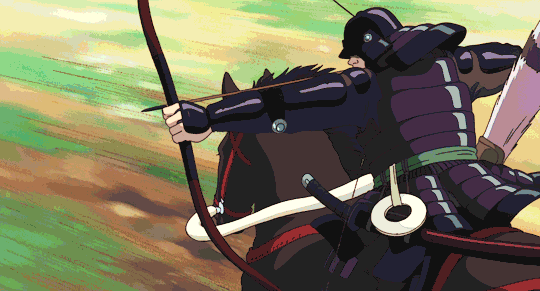
(grabbing arrows out of the air and shooting them back was not an established tactic in the Sengoku period, shockingly, but Ashitaka has a magic arm!)
The Sengoku period ended with a series of successful unifying generals succeeding each other: first the powerful Oda Nobunaga (villain of many a videogame) took Kyoto, then after he was assassinated, vassal-turned-rival warlord Tokugawa Ieyasu finally stepped up to take out his successors and finish the job. The famous Battle of Sekigahara in 1600 put a definite end to all the wars and established a new “Tokugawa Shogunate” to rule Japan. As a result, the next several hundred years were known as the Tokugawa Period, or the Edo period, after the capital that Tokugawa established (now known as Tokyo).
With the end of the Sengoku period, all those warlike samurai had to be turned into peaceful administrators. Unlike European feudalism, lesser samurai were not awarded land by their lords; instead they were beholden to a daimyō who paid them a stipend. The daimyō, in turn, were beholden as vassals to the shogunate.
As the population exploded (with better agricultural tech and trade, and no more massive wars), the country became increasingly urbanised around the castles of daimyō, and a whole lot of commerce took off, with the shogunate issuing both coins and many types of paper money. However, the shogunate also enforced strict policy of isolation, banning all foreigners except the Dutch, who were only permitted to land at an artificial island in Nagasaki, acting as middlemen between Japan and China to import silk in return for silver.
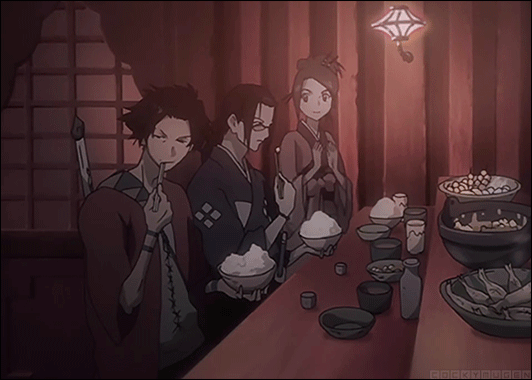
This new economy needed its administrators, and in the new era, the samurai were not soldiers so much as bureaucrats. It was only during this peacetime period that notions of samurai honour began to be established, though not nearly to the degree that they’re mythologised, as we’ll discuss below.
Art such as ukiyo-e increasingly started to represent the ‘floating world’ of Edo, full of theatre and sex work and other entertainment, despite the government officially condemning such things on Confucian moral sentiments. (Which are not the same as Christian ones: there was no specific taboo against gay sex, and people had a lot of it.) Under the control of the Tokugawa shogunate, the old aristocracy and the temples were allowed to stick around, but closely watched. Confucianism took over from Buddhism but Buddhism stuck around, while Shinto was integrated as a state ideology.
These various pleasures were enjoyed by the vastly inflated caste of samurai, who enjoyed hereditary privileges, symbolised by the right to carry a katana (which was not an effective battlefield weapon compared to the bow or spear, but a great thing to wear to show how loaded you were). But there were all kinds of other classes too represented in period pieces; complex peasant villages, a small but growing urban proletariat, numerous merchants and so forth.
From the central parts of the archipelago, ‘Japan’ expanded North into Hokkaido, still populated by the Ainu people, and set about genociding them; it also expanded south into the Ryukyu islands, but wasn’t quite as successful with genociding the natives.
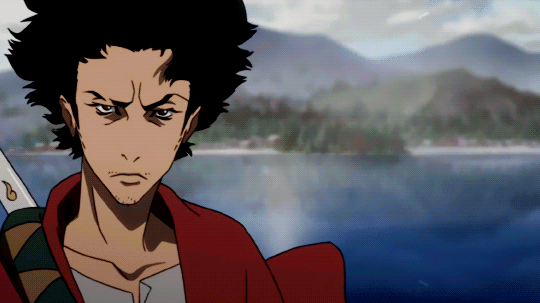
(Mugen, one of the few characters native to the Ryukyus in anime.)
Outside of these campaigns of colonisation, the country was relatively peaceful. The Tokugawa Shogunate, nervous of any daimyōs getting too big for their britches, put limits on military power, and things went along for a couple of hundred years.
This state of affairs came to an abrupt halt with the “Meiji restoration” in the 19th century. In the 1854, an American, Commodore Matthew Perry, decided he wanted to open trade with Japan and wouldn’t take no for an answer. Using new American weapons, he blew up some buildings demanded the opening of the ports. Realising they were severely outgunned, the Tokugawa shogunate came to terms, admitting American ships and allowing them to establish a consul.
With foreign trade came financial catastrophes as the existing system of gold-backed coinage collapsed, massive cholera outbreaks, and severe weakening of the shogunate. The daimyōs started arming up; before long the Emperor Meiji led a short war to end Tokugawa rule, and put the old imperial house back in charge.
The new regime was very nervous of the scary European powers who had been carving up the world through colonialism, and the Americans offering supposedly ‘better’ terms. They set about a rapid program of ‘modernisation’ on European lines, abolishing most of the old feudal hereditary rights and heavily redistributing land. This spelled the end for the samurai caste; the shogunate fought, and lost, a few battles but the tide of history had turned against them. So that’s where we stop; while the 20th-century history of Japan is full of interesting events, it’s definitely outside the territory of jidaigeki.
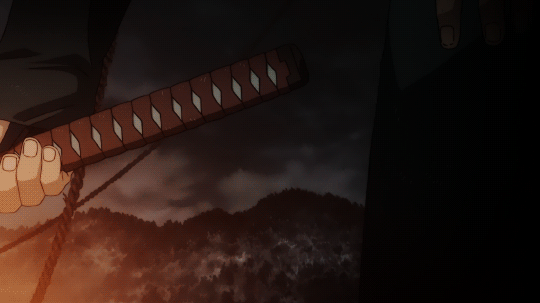
Of course, ruthless warlords turned feudal bureaucrats is not how most people remember the samurai today! The modern memory of the samurai in the West, and to a more complicated extent Japan, is total badasses with really cool swords who are obsessed with honour.
That romantic narrative has a lot to do two things. First is the far-right nationalism of the early 20th century, when writers such as Inazo Nitobe created a fiction that the samurai were deeply sworn to a special code of bushido, writing first in English only to face heavy criticism once his work reached Japan. As Tofugu write in an excellent artice, though there were certainly concepts of honour among the samurai as in all cultures, the idea of a universal code that the whole class obeyed, and component ideas such as that seppuku (ritual suicide) was widespread, is basically all fiction.
As we’ve seen, samurai were as ruthless and willing to compromise any of their supposed principles as anyone, and exactly what the ‘rules’ were would vary by household. At their worst points, they would treat those beneath them as callously and brutally as the ancient spartiates. During the total social breakdown of the Sengoku period, there was even a practice of straight-up random murder called ‘crossroads killing’ (tsujigiri).
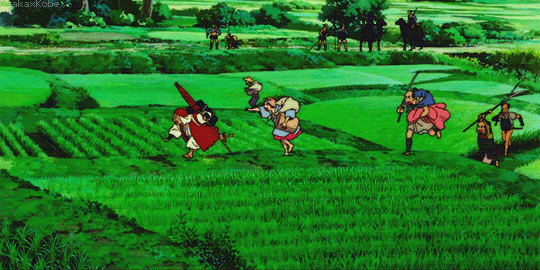
It was only after most of the wars were over that the samurai started to build their own mythology of proper, honourable behaviour as part of a national mythmaking exercise. This idea of absolute loyalty found fuel in occasional outbreaks of violence like the story of the Forty-Seven Rōnin. Such mythmaking is all too familiar in history: consider the very similar case of the spartiates, likewise brutal feudalists, whose reign of terror was romanticised by slightly later historians as a supposedly free group of super-badass warriors.
Moreover, while violence was much rarer in the time the samurai were making up bushido, it was by no means universal either. The poorer samurai often couldn’t live on their stipend and would act up in various ways. Tofugu write:
But not all samurai enjoyed life in the upper class. Low status samurai made small stipends that barely afforded daily living. Bound by the Tokugawa era’s strict laws that forbade outside unemployment, some of these samurai renounced their status to become artisans or farmers (Cunningham).
Still other Tokugawa era samurai could not find employment. These vagrants often turned to dishonorable acts. As Don Cunningham explains in Taiho-jutsu: Law and Order in the Age of the Samurai, "Facing unemployment and an ill-defined role within their new society, many samurai resorted to criminal activities, disobedience, and defiance” (Cunningham). With few prospects and mounting frustrations, these samurai dressed and spoke flamboyantly, harassed lower classes, joined gangs, and brawled in the streets.
And when violence between samurai did take place, it was rarely the kind of graceful sword duel between equal master swordsmen that samurai are associated with in film. Even the heavily romanticised duellist Miyamoto Musashi, who fought towards the end of the Sengoku period and the beginning of the Tokugawa Shogunate, won many of his duels through sneak attacks and sheer aggression.
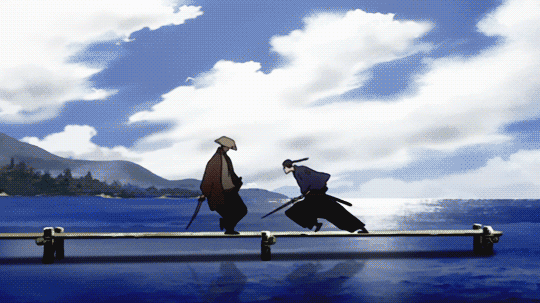
But this mythology of Japan as an honourable warrior culture was very useful for the imperialist government looking for a national myth to motivate a turn to imperialist expansion, so despite being largely bullshit, writing such as Nitobe’s became widely distributed during the imperialist years (more from Tofugu):
Now that it had found an ideology, the Japanese government had to make bushido “leaven among the masses” or moving propaganda. “Civilization and Enlightenment” and “Rich Nation, Strong Army” became wartime slogans. The nationalized education system streamlined curriculums to spread government rhetoric and foster an enlightened, battle-ready citizenry.
The national curriculum changed history to fit government agendas. “The Edo-period texts that showed the greatest nostalgia for pre-Tokugawa conditions were carefully selected, condensed, and edited to purge them of those elements which ran counter to the national project in the early twentieth century” (Benesch 21).
Mandatory texts romanticized past events and personalities. According to Oshii, “False images were created out of government necessity.” Thanks to the government’s agenda, unfamiliar entities like bushido, Hagakure and Miyamoto Musashi entered the mainstream conscious.
On the back of this fascist mythology, the second world war saw grisly incidents like the contest to kill 100 people using a sword, when Japanese newspapers reported the story of two officers invading China competing to kill more people by sword, though in reality there may not have been a contest per se and most of their killings were of prisoners. (This took place in the context of other, far more horrifying atrocities against the population of Nanjing, including tens or hundreds of thousands of murders and rapes).
Such a view of the samurai (and often pre-modern Japanese people in general in stories about ninjas or yakuza) as fanatical honour-bound warriors is still basically the default for Western depictions of samurai, such as Genndy Tartakovsky’s Samurai Jack. (We won’t be watching that tonight, but we might do a Tartakovsky night somewhere down the line.) But I wanted to make clear before we watch a bunch of films about cool samurai: Japan’s history was plenty bloody, but basically in the same ways as most other places. The samurai were pretty interesting, but hardly unique among feudal martial/landlord castes.
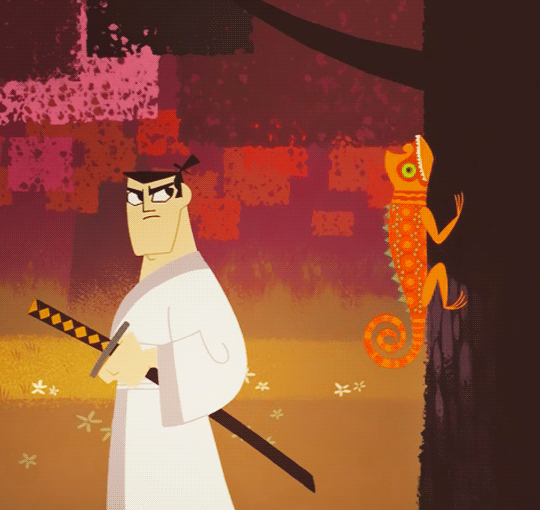
…this is a film night post, right?
So, onto the films! Most of the modern image of samurai comes from the subject of tonight’s film night: 20th- and 21st-century samurai films, which fall under the heading of jidaigeki (period drama), and its subgenre chanbara focused on swashbuckling samurai swordfights.
These films by no means present samurai as uniformly honourable and noble. They’re apparently very similar to Westerns, with influence going both ways. Per wiki, jidaigeki TV shows and films established a variety of narrative conventions to mark heroes (eye makeup) and villains (messy hair and often armour); like comic-book characters, many jidaigeki main characters would have catchphrases to drop before the inevitable big fight. But the genre is huge, with all kinds of films ranging from shlocky action through wacky comedy to serious drama.
Tonight we are focused on samurai in animation, but I should briefly note that some of the conventions of samurai swordfights in animation come from live film. One famous trope, of two samurai cutting at each other, holding a pose for a beat, and then one of them collapsing in a spray of blood, originates in the film Sanjuro [1962] by good old Akira Kurosawa. [While most jidaigeki did not get any major worldwide release, Kurosawa got a huge reputation in the West, and his films were widely imitated in Westerns like The Magnificent Seven and even sci-fi films like Star Wars.]
So! Animation! Samurai have been popular in anime for as long as there has been anime. Or indeed, before there was a specific tradition of anime as we’d recognise it: some of the earliest experiments in animation in Japan featured samurai, such as Namakura Gatana (1917) by Jun’ichi Kōuichi.
This four-minute silent film, contemporary with other extremely early animation like Winsor McKay’s Gertie the Dinosaur (1914), was actually rediscovered by accident in an antique shop in 2008. It features a samurai who buys a blunt sword and gets beaten up repeatedly while testing it. The art’s stylisation is much more reminiscent of ukiyo-e than the later anime style: the samurai and the merchants have those long faces and period-appropriate chonmage.
Unlike McKay, the animation looks like it was achieved with paper cutouts, following in the footsteps of J. Stuart Blackton’s early experiments but with considerably more narrative. (A lot of early Japanese animation, such as the work of Noborō Ōfuji in the 20s, also used this style!) There’s definitely an element of ‘ooh look at what we can do with this medium!’, with long sequences of characters’ eyeballs wandering about; modern ideas of timing and weight were not yet established. Still, it’s pretty great to see animation from more than a century ago!
(If you’re curious about this period of animation, this paper names a lot of other examples of Japanese animation in the 1910s and gives a little historical background.)
Another example of early jidaigeki animation is Benkei Tai Ushikawa (1939), directed Kenzō Masaoka, one of the first Japanese animators to use cels and multiplane cameras, and to animate to sound.
The film tells the story of legendary Heian-period warrior-monk Benkei, and manages to fit in multiple comedic swordfights as well as a song. The influence of American studios like Fleischer is very clear: we have lots of exaggerated motion and short cycles.
Of course, once anime really got going after the end of WWII, there was a whole lot of jidaigeki. Freed from the limits of real actors, anime got very, very good at making stylised swordfights look absolutely cool as shit, and many series and films not directly about samurai would feature an elite, katana-wielding swordsman. We can’t possibly survey all of it, nor am I qualified to do so, but I’m definitely going to pick out some personal faves.
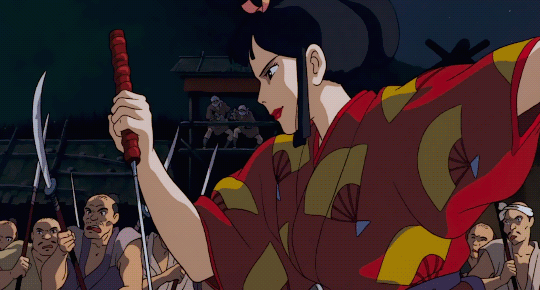
One reassuring thing is that, in many of these films, the image of samurai is by no means a particularly positive one. Regardless of the period, many samurai in these films come across as corrupt, cruel and avaricious. The Shogun and Emperor, also, tends to come across as sinister figures, sending out ruthless assassins in pursuit of immortality or suppression of their enemies. If anyone as painted as heroic, it is often - as in westerns - a social outcast, typically a wandering rōnin.
One absolute favourite I won’t be showing tonight, but which I could never go without mentioning, is Hayao Miyazaki’s incredible film Mononoke-Hime (Princess Mononoke) [1997]. Mononoke-Hime tells the story of a conflict between a group of humans, mostly outcasts (such as lepers and sex workers) during the late Muromachi/early Sengoku period, colonising an area of forest under the rebellious noblewoman Lady Eboshi. Eboshi’s people have built a large ironworks, and they are stripping the forest to obtain iron for firearms to fend off the local daimyō’s forces, not to mention the angry animal spirits of the forest resisting their incursions.

We see this through the eyes of Prince Ashitaka, the pride of a small Emishi village far away from the conflict, who is cursed after defending his village an injured demon boar. His curse makes him an outcast, but he goes to seek the cause of the boar’s rage, instructed by his elders to ‘see with eyes unclouded by hate’. Arriving in Irontown and rescuing an injured oxherd as soon as he arrives, Ashitaka walks a careful line between the two sides at war.
He soon meets San, the eponymous princess of beasts. San is a girl raised by proud, noble wolf spirits who, like most of the animal spirits, wants nothing more than destruction of Eboshi and Irontown. Ashitaka manages to get on her good side, more or less, and witnesses the forest animals massing for war.
The conflict comes to a head when, backed by the distant emperor whose forces are led by the corrupt priest Jigo, Eboshi slaughters the boars and wolves with her guns and bombs. Along with Jigo’s troops, she goes into the depths of the forest and kills the serene, benevolent Deer God, hoping to steal its head… Ashitaka and San are forced to intervene to save the humans as things get downright apocalyptic.

Now, my idea for Animation Night was to highlight slightly lesser-known animation than Ghibli, so… the main reason we’re not watching it tonight is that I am pretty sure most of you have already seen it :p But, that said, it is probably my favourite film of all; the subtlety of its conflict (arising from a time of deep disillusionment in Miyazaki’s life), the gorgeous animation, Joe Hisaishi’s incredible soundtrack. So many impactful sequences and distinctive images. No post about jidaigeki in animation would be complete without it! But because it’s so familiar, I am not going to show it tomorrow.
Instead, our main feature tonight is Sword of the Stranger [2007], probably the most direct adaptation of samurai-film conventions to animation. It’s the work of Bones, renowned for their work on things like the Cowboy Bebop film, FMA: Brotherhood, and recently Mob Psycho 100 among many many other excelelnt works throughout the 2000s, and directed by long-time Bones episode director Masahiro Andō.
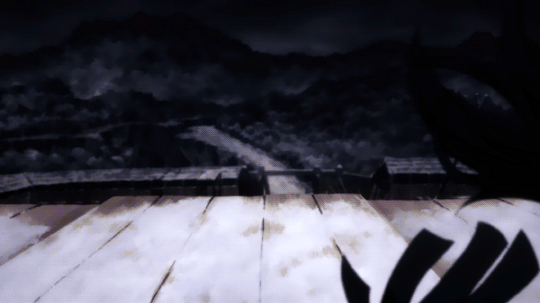
The animation is strong throughout, but among sakuga circles, it’s best known for the incredible fight sequence at the end of the film animated by Yutaka Nakamura, aka Yutapon. Who’s the cubes guy, if you’re keeping track, but also known as one of the best fight animators in the whole business! The choreography, camera work, weight etc. is just one of the best bits of fight animation you’ll get to see; we get a full two minutes of pure Yutapon goodness.
But what’s it actually about? Sword of the Stranger takes us (as so many samurai films do) to the Sengoku period, when as we’ve seen, any sense of a unified Japan has dissolved into small warring polities whose lords vie for land in battle after battle. Into this tense milieu arrives a group of soldiers who have come to Japan from Ming-dynasty China, for unknown reasons, led by a ruthless westerner called Luo-Lang. They are pursuing a young boy called Kotaro, who - after monks help him escape the Ming - falls in with a skillful but taciturn rōnin going simply by Nanashi (no-name). As Nanashi and his new ward get used to each other, the Ming guys are coming into conflict with the local lord hosting them, who wants to know why they’re here.

Naturally, revelations start to flow: who Nanashi really is, and why the Ming guys want Kotaro so badly; meanwhile other lords are getting in on the action. It escalates into a big battle and a climactic duel (as you might expect). The execution is incredible; it’s gritty, weighty and well-directed. I was surprised that Andō has never directed another film because this one really stands out.
As far as content goes, the main thing to note is that Stranger is as violent as you’d expect from a chanbara film, with plenty of blood and dismemberment and sudden deaths by arrow. I haven’t watched it through, though I can’t wait to finally see it.
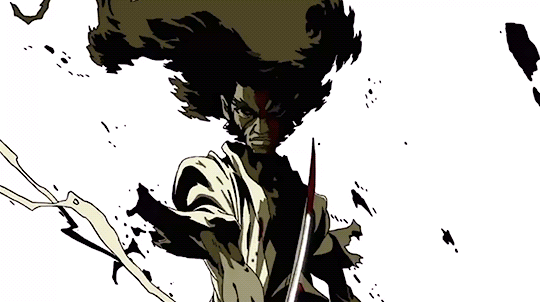
Our other major feature is the five-episode OVA Afro Samurai, which is only loosely a jidaigeki but certainly influenced by all the tropes of samurai films. This OVA just oozes style, and it has quite an interesting background of international collaboration.
Originally, it was a manga by Takashi Okazaki, a Japanese fan of hip-hop and soul, a kinda silly story about various larger-than-life characters competing for a magic headband in a Japan that’s a blend of feudal and futuristic. The main character, Afro, is loosely inspired on the historical Black samurai Yasuke who served under Oda Nobunaga. The manga is in supposedly high on style but light on substance; at some point, however, it caught the eye of anime producers, and while they were working on it, a trailer landed in the hands of Samuel L Jackson.

Jackson, who has of course spent much of his acting career playing both stoically masculine badasses like Afro and kinda sardonic, swearing guys like his sidekick Ninja Ninja, loved it; he offered to get involved with the project, with him voicing both characters. Obviously they said yes, especially since along with Jackson came music by RZA from the Wu-Tang Clan.
With Jackson’s involvement, Afro Samurai expanded to become a five-episode OVA. Unusually for anime, no Japanese-language version was ever made; the English-language version was broadcast in Japan with subtitles. With Jackson voicing both main characters, a fair bit of it is simply Jackson talking to himself! The rest of the voicing varies, pretty much usual American dub style.
If you recall Takeshi Koike from the night we watched Redline and Trava: Fist Planet, though I’m fairly sure he wasn’t an animator on the final OVA, he did work on the pilot, and his style - extreme perspective, heavy black shading, etc. - is definitely still an influence. The film doesn’t remotely hold back on the sex and violence; the bits I’ve watched are damn tropey but hey, I respect its commitment to just going all the way with ridiculous samurai-film bullshit. And the team Gonzo (also known for the classic airship-geopolitics adventure Last Exile, and the highly experimental Gankutsuo: The Count of Monte Cristo) had the animation and direction talent to pull it off.

The film focuses on Afro’s quest for revenge on a gunslinger called Justice, who killed his dad and took the magic No. 1 Headband, and now leads a clan called Empty Seven of other headband-wearers. On the way up, Afro has to deal with the various other members of Empty Seven, not to mention various unafilliated fighters who would like nothing more than take the No. 2 Headband from him, giving them the right to their own crack at Justice. This slightly flimsy plot is, as you’d expect, mostly an excuse for over-the-top swordfights.
The main content warning for Afro Samurai, as well as huge amounts of blood and highly stylised violence, is that the woman Afro meets and briefly has sex with in episode 2, Otsuru/Okiku, is treated very poorly by the narrative: basically she is secretly working for the bad guys but turned good because Afro’s just so sexy, and she’s killed off seconds after that comes out; other women are largely background characters like bartenders and sex workers with little impact on the story. It’s a deeply frustrating choice - perhaps not surprising given the obvious exploitation-film influences but man, I wish they’d not gone there. The rest of the film avoids this territory if only by almost exclusively featuring men.
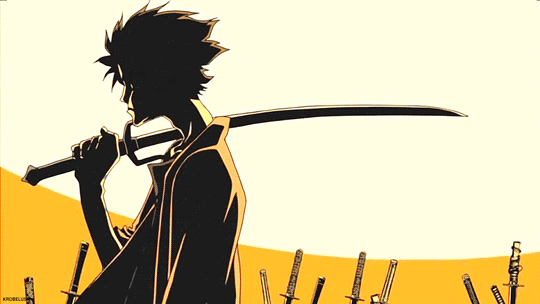
Now, Afro Samurai is not the first time that hip-hop and samurai themes have come together. A few years earlier was Shinichiro Watanabe’s Samurai Champloo, which attempts to do what Cowboy Bebop did blending spaceships, westerns and jazz, but with samurai stories and hip-hop instead. It brought on plenty of very stylish animators - you may recognise Koike once again applying his style in the intro animation there, while another episode features an early appearance of Masaaki Yuasa as a key animator during a drug sequence.
Champloo is set in the Edo period, though historical accuracy is not high on its list of concerns, and it gleefuly mixes in anachronisms from across the samurai genre. It follows two swordsmen - the orthodox, quiet Jin and the carefree and wild Mugen - who both end up making a promise to accompany a young girl called Fuu as she searches for ‘the samurai who smells of sunflowers’. This is for the most part just a frame story to lead the protagonists through a picaresque series of adventures in Edo-era Japan, getting involved with yakuza, ukiyo-e painters, eating contests, secret Christians and all sorts of other shenanigans.
It’s a lot of fun, I think I actually like it more than Bebop. I wrote a little about it a fair while ago, mostly to muse on its portrayal of gay characters. To his credit, Watanabe was committed to showing the diversity of the Japanese archipelago, with Mugen hailing from the Ryukyu Islands (then a separate polity fracing colonisation) and making a point of showing characters with more varied skin tones than a lot of anime. While I have mixed feelings about much of Watanabe’s work, I think he did very good with Champloo.
Naturally we don’t have time to binge all 26 episodes, but I wanted to give you a glimpse of how it starts - with encouragement to pick it up if you like the style!
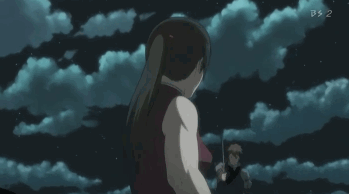
Another favourite jidaigeki TV series is Production I.G.’s adaptation of Seirei no Moribito (Guardian of the Spirit). The book is by Nahoko Uehashi, an ethnologist turned fantasy author, and that background definitely shines through in her depiction of a not-quite-Japan; recognisable culturally (including an Ainu-inspired group and the emperor’s palace) but still a fantasy world. The first novel in her Moribito series got picked up by Production I.G. (of Ghost in the Shell: Stand Alone Complex fame), directed by Production I.G. veteran Kenji Kamiyama, and among the animators were some work by webgen stars, such as ryo-timo. The result is something really solid.
The series concerns a woman called Balsa, an expert spear fighter who has sworn not to kill; she is on a mission to save a certain number of lives after a traumatic incident in her past. After intervening in a supposed accident when a certain Prince Chagum’s procession falls off a high bridge, she finds herself hired by one of the Emperor’s several wives, who faces the nasty problem that the same Emperor is trying to surreptitiously assassinate her son… believing that the young Prince Chagum contains a seed which will bring destruction to the land. Balsa takes the job, and flees with Chagum, with the Emperor’s swordsmen in hot pursuit of the supposed kidnapper.
Naturally, there’s a lot more going on; the egg that’s actually inside Chagum is not what anyone thinks. The situation spreads to a scholar in the capital who starts to doubt the official history, while Balsa seeks help from this amazing old shaman called Torogai who brings that ‘extremely powerful grandma’ energy.

Moribito has some brutally intense spear fights, but it also has a very gentle energy much of the rest of the time, with a gorgeously painted natural setting and really strong characterisation. Unusually, it’s a story in which nearly every major character ends up sympathetic if sometimes misguided, a setup I like a lot even if the plot does lean a bit on miscommunication.
As animation… like many Production I.G. works, such as GitS:SAC, the characters are beautifully drawn, but often very stoic and stationary outside of the action scenes. But also like GitS:SAC, when it gets going, it’s got some fantastic animation; Production I.G. are absolute masters of creating convincing movement through 3D space. There’s also some delightful weirdness in the spirit world scenes, full of huge majestic beasts…
Also worth discussing on that note is Mushishi, which takes quite a different tone to the rest of these action-heavy picks. Another period fantasy, this time in the late Edo period, Mushishi deals with a quiet, one-eyed traveler called Ginko who can see spirits called Mushi.
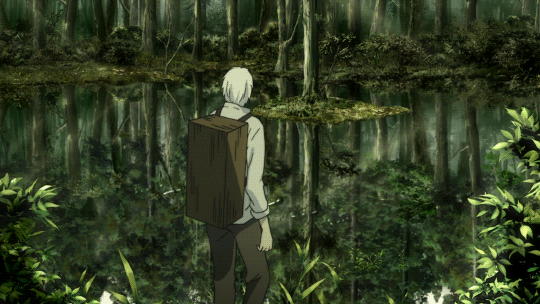
As Ginko travels about, he gets drawn into various peoples’ spirit problems. The spirits are more like planckton than anything, small drifting creatures; the show takes the creative measure of animating them on a different framerate to emphasise their strangeness. Like microorganisms, they can cause various diseases without having any particular ill will.
Mushishi is a very gentle show, full of richly painted forests and other such gorgeous scenery, but it will absolutely escalate into outright horror on occasion - the second episode, for example, features a boy whose eyes are being eaten by the Mushi. The only real continuity is Ginko himself, and the Mushi he meets in each location.
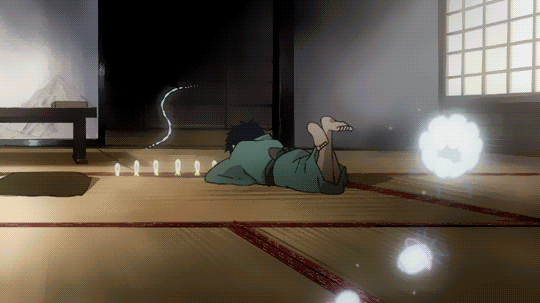
I haven’t yet seen Mushishi in full, so I can’t tell you where it goes with this premise, but it’s definitely a very creative example of jidaigeki. My current plan is, because the playlist is already getting rather long, that we’ll return to mushishi next week for our night of horror animation!
Which means we’re going to watch:
- Namakura Gatana [1917]
- Benkei tai Ushiwaka [1939]
- Sword of the Stranger [2007]
- Seirei no Moribito episode 1 [2007]
- Samurai Champloo episode 1 [2004]
- Afro Samurai OVA [2007]
- and if we have time, our usual music video outro
So. I realise that’s been an epic of a post; I got very excited about researching samurai history and cracked open the textbooks, but I hope the result was something interesting to read!
Animation Night 24 will kick off at 7pm UK time tomorrow (11am California, 2pm New York, 2am Singapore), which is (for me) Thursday 22 October. The place will, as usual, be my channel twitch.tv/canmom.
I’m really excited for this one: a ton of my favourite animated films are jidaigeki and this was a real joy to research. Can’t wait to see you there!
Comments